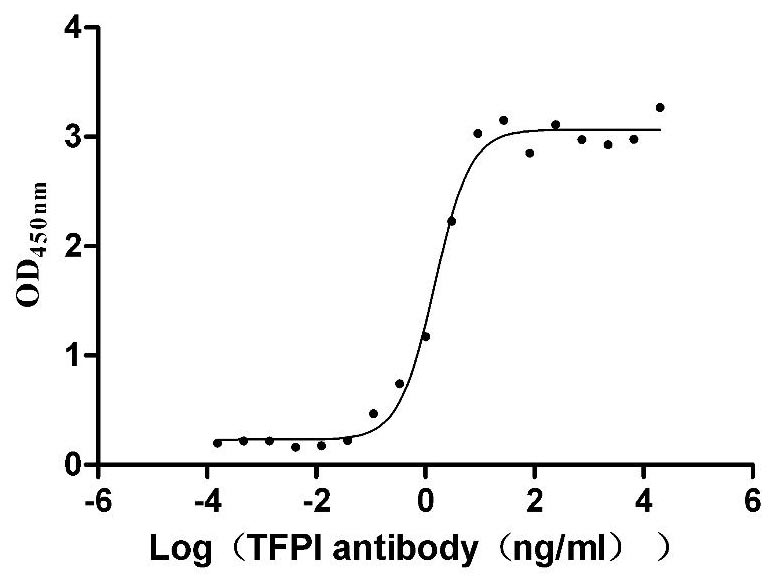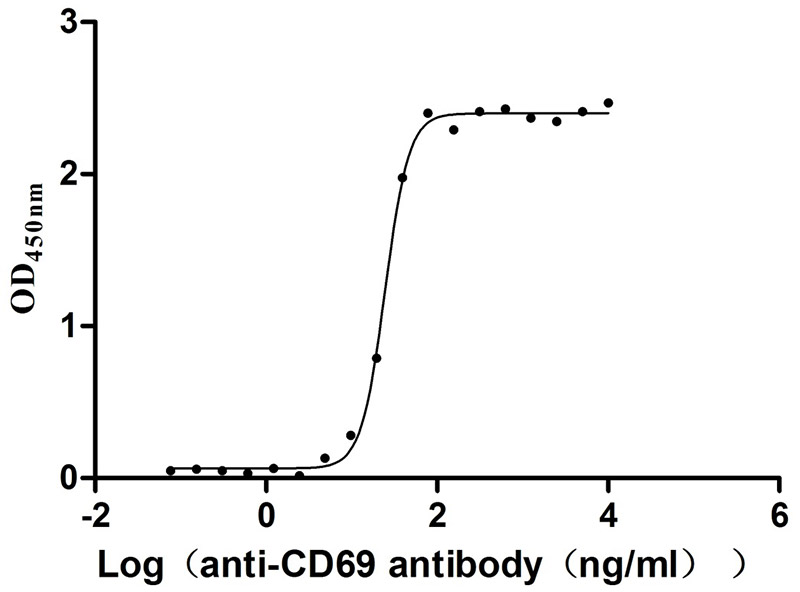Recombinant Mouse Frizzled-3 (Fzd3), partial
-
货号:CSB-YP713959MO1
-
规格:
-
来源:Yeast
-
其他:
-
货号:CSB-EP713959MO1
-
规格:
-
来源:E.coli
-
其他:
-
货号:CSB-EP713959MO1-B
-
规格:
-
来源:E.coli
-
共轭:Avi-tag Biotinylated
E. coli biotin ligase (BirA) is highly specific in covalently attaching biotin to the 15 amino acid AviTag peptide. This recombinant protein was biotinylated in vivo by AviTag-BirA technology, which method is BriA catalyzes amide linkage between the biotin and the specific lysine of the AviTag.
-
其他:
-
货号:CSB-BP713959MO1
-
规格:
-
来源:Baculovirus
-
其他:
-
货号:CSB-MP713959MO1
-
规格:
-
来源:Mammalian cell
-
其他:
产品详情
-
纯度:>85% (SDS-PAGE)
-
基因名:
-
Uniprot No.:
-
别名:Fzd3; Frizzled-3; Fz-3; mFz3
-
种属:Mus musculus (Mouse)
-
蛋白长度:Partial
-
蛋白标签:Tag type will be determined during the manufacturing process.
The tag type will be determined during production process. If you have specified tag type, please tell us and we will develop the specified tag preferentially. -
产品提供形式:Lyophilized powder
Note: We will preferentially ship the format that we have in stock, however, if you have any special requirement for the format, please remark your requirement when placing the order, we will prepare according to your demand. -
复溶:We recommend that this vial be briefly centrifuged prior to opening to bring the contents to the bottom. Please reconstitute protein in deionized sterile water to a concentration of 0.1-1.0 mg/mL.We recommend to add 5-50% of glycerol (final concentration) and aliquot for long-term storage at -20℃/-80℃. Our default final concentration of glycerol is 50%. Customers could use it as reference.
-
储存条件:Store at -20°C/-80°C upon receipt, aliquoting is necessary for mutiple use. Avoid repeated freeze-thaw cycles.
-
保质期:The shelf life is related to many factors, storage state, buffer ingredients, storage temperature and the stability of the protein itself.
Generally, the shelf life of liquid form is 6 months at -20°C/-80°C. The shelf life of lyophilized form is 12 months at -20°C/-80°C. -
货期:Delivery time may differ from different purchasing way or location, please kindly consult your local distributors for specific delivery time.Note: All of our proteins are default shipped with normal blue ice packs, if you request to ship with dry ice, please communicate with us in advance and extra fees will be charged.
-
注意事项:Repeated freezing and thawing is not recommended. Store working aliquots at 4°C for up to one week.
-
Datasheet :Please contact us to get it.
相关产品
靶点详情
-
功能:Receptor for Wnt proteins. Most of frizzled receptors are coupled to the beta-catenin canonical signaling pathway, which leads to the activation of disheveled proteins, inhibition of GSK-3 kinase, nuclear accumulation of beta-catenin and activation of Wnt target genes. A second signaling pathway involving PKC and calcium fluxes has been seen for some family members, but it is not yet clear if it represents a distinct pathway or if it can be integrated in the canonical pathway, as PKC seems to be required for Wnt-mediated inactivation of GSK-3 kinase. Both pathways seem to involve interactions with G-proteins. Activation by Wnt5A stimulates PKC activity via a G-protein-dependent mechanism. Involved in transduction and intercellular transmission of polarity information during tissue morphogenesis and/or in differentiated tissues. Plays a role in controlling early axon growth and guidance processes necessary for the formation of a subset of central and peripheral major fiber tracts. Required for the development of major fiber tracts in the central nervous system, including: the anterior commissure, the corpus callosum, the thalamocortical, corticothalamic and nigrostriatal tracts, the corticospinal tract, the fasciculus retroflexus, the mammillothalamic tract, the medial lemniscus, and ascending fiber tracts from the spinal cord to the brain. In the peripheral nervous system, controls axon growth in distinct populations of cranial and spinal motor neurons, including the facial branchimotor nerve, the hypoglossal nerve, the phrenic nerve, and motor nerves innervating dorsal limbs. Involved in the migration of cranial neural crest cells. May also be implicated in the transmission of sensory information from the trunk and limbs to the brain. Controls commissural sensory axons guidance after midline crossing along the anterior-posterior axis in the developing spinal cord in a Wnt-dependent signaling pathway. Together with FZD6, is involved in the neural tube closure and plays a role in the regulation of the establishment of planar cell polarity (PCP), particularly in the orientation of asymmetric bundles of stereocilia on the apical faces of a subset of auditory and vestibular sensory cells located in the inner ear. Promotes neurogenesis by maintaining sympathetic neuroblasts within the cell cycle in a beta-catenin-dependent manner.
-
基因功能参考文献:
- The s report here that Sonic Hedgehog (Shh)-Smoothened signaling downregulates Shisa2, which inhibits the glycosylation and cell surface presentation of Frizzled3 in rodent commissural axon growth cones. PMID: 28885142
- Results suggest that Celsr3 and Fzd3 orchestrate the formation of a scaffold of pioneer neurons and their axons during embryogenesis. This scaffold extends from prethalamus to ventral telencephalon and subcortex, and steers reciprocal corticothalamic fibers. PMID: 27170656
- Frizzled3 is required to shape the pattern of RBC somas and dendrites, and the structural and functional connectivity between rods and RBCs. Our results highlight novel functions for Fzd3 in regulating retinal development. PMID: 27214687
- Temporal and spatial expression profiles of Frizzled 3 in the ovary during the estrous cycle has been reported. PMID: 26909900
- Celsr3 and Fzd3 enable immature neurons to respond to Wnt7, upregulate Jag1 and thereby facilitate feedback signals that tune the timing of neural progenitor cell fate decisions via Notch activation. PMID: 26939553
- This study demonstrated that Frizzled3 Controls Axonal Polarity and Intermediate Target Entry during Striatal Pathway Development. PMID: 26490861
- In Fz3(-/-) limbs, dorsal axons stall at a precise location in the nerve plexus, and, in contrast to the phenotypes of several other axon path-finding mutants, Fz3(-/-) dorsal axons do not reroute to other trajectories PMID: 24347548
- Wnt3a/Frizzled-3 signaling plays important role in regulating the proliferation and differentiation of neural crest cells and various developmental stages of melanocyte precursors. PMID: 24815018
- Fz3 and Fz6 have partly interchangeable roles in tissue polarity signaling for epithelial orientation and axon growth and guidance PMID: 25294940
- The first signal, controlled by cadherin, EGF-like, laminin G-like, seven-pass, G-type receptor (Celsr) 2, Celsr3, Frizzled3 (Fzd3) and Van Gogh like2 (Vangl2) organizes multicilia in individual cells (single-cell polarity) PMID: 25024228
- Celsr2-3 and Fzd3 regulate axonal navigation in the forebrain by using mechanisms different from classical epithelial core planar cell polarity, and require interacting partners other than Vangl1-2 that remain to be identified. PMID: 25002511
- Several central nervous system axon tracts require Fz3 function as early as embryonic day 11.5, and that Fz3 is required for pathfinding by dopaminergic and serotonergic axons in the brain and by a subset of optic tract axons. PMID: 24799694
- Frizzled3 endocytosis is part of the key mechanism for growth cone steering PMID: 24305805
- Celsr3 and Fzd3 are required during murine embryogenesis to specifically control the guidance and growth of enteric neuronal projections relative to the longitudinal and radial gut axes. PMID: 23478408
- The results of this study suggested distinct roles for Fz3 during sympathetic neuron development; Fz3 acts at early developmental stages to maintain a pool of dividing sympathetic precursors. PMID: 21325504
- Fzd3 and Fzd6 deficiency results in a severe midbrain morphogenesis defect. PMID: 19842188
- commissural axons in mice lacking the Wnt receptor Frizzled3 displayed anterior-posterior guidance defects after midline crossing; Wnt-Frizzled signaling guides commissural axons along the anterior-posterior axis of the spinal cord PMID: 14671310
- In the inner ear of a Vangl2 mutant (Looptail; Lp), Fz3 and Fz6 proteins accumulate to normal levels but do not localize correctly at the cell surface. PMID: 16495441
- Together, our data support the idea that protein asymmetry plays an important role in the development of PCP, but the colocalization and interaction of Fz3 and Vangl2 suggests that novel PCP mechanisms exist in vertebrates. PMID: 16687519
显示更多
收起更多
-
亚细胞定位:Membrane; Multi-pass membrane protein. Cell membrane; Multi-pass membrane protein. Cell surface. Apical cell membrane; Multi-pass membrane protein.
-
蛋白家族:G-protein coupled receptor Fz/Smo family
-
组织特异性:Expressed in the cortex, diencephalon, rostral brainstem and little or no staining is seen in the striatum or cerebellum. Expressed in both hair cells and supporting cells in the utricle, saccule, cristae and the organ of Corti in the inner ear (at protei
-
数据库链接:
KEGG: mmu:14365
STRING: 10090.ENSMUSP00000115325
UniGene: Mm.214687
Most popular with customers
-
Recombinant Human Tissue factor pathway inhibitor (TFPI), partial (Active)
Express system: Mammalian cell
Species: Homo sapiens (Human)
-
Recombinant Human C5a anaphylatoxin chemotactic receptor 1 (C5AR1)-VLPs (Active)
Express system: Mammalian cell
Species: Homo sapiens (Human)
-
Recombinant Mouse Tyrosine-protein kinase Mer (Mertk), partial (Active)
Express system: Mammalian cell
Species: Mus musculus (Mouse)
-
Recombinant Human Lymphocyte antigen 6 complex locus protein G6d (LY6G6D) (Active)
Express system: Yeast
Species: Homo sapiens (Human)
-
Recombinant Macaca fascicularis Trophoblast glycoprotein (TPBG), partial (Active)
Express system: Mammalian cell
Species: Macaca fascicularis (Crab-eating macaque) (Cynomolgus monkey)
-
Recombinant Human Early activation antigen CD69 (CD69), partial (Active)
Express system: Mammalian cell
Species: Homo sapiens (Human)
-
Recombinant Macaca fascicularis CUB domain containing protein 1 (CDCP1), partial (Active)
Express system: Mammalian cell
Species: Macaca fascicularis (Crab-eating macaque) (Cynomolgus monkey)



















